Interview: Homer Bell Bell-Air Ranch
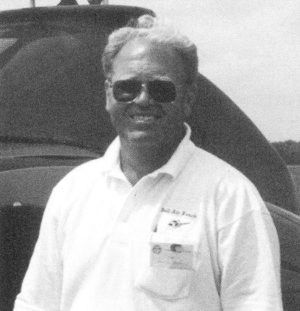
Homer Bell
When you interview Homer Bell, it’s really not so much a question and answer session as it is a question and “stream of consciousness.” One question and Homer is off and running. Not that there’s anything wrong with that. He’s a delight to listen to and quite a colorful character with a true love of grass-roots helicopter flying.
He and his wife Sharon host an annual get-together for homebuilt helicopter enthusiasts at their Bell-Air Ranch, which is located in Southestern Ohio near Waynesville. Before running out of tape, I managed to get some of his thoughts on homebuilt helicopters, his early days and where homebuilts are headed.
ROTORCRAFT: Let’s talk about homebuilt helicopters.
HOMER BELL: There’re a lot of people who’d like a homebuilt helicopter, but they’re so expensive. And then what do you do? You can hardly use them for transportation, really. It’s not practical when you come right down to it. If you can’t use it somehow in your work or business, you’ve got to have fairly deep pockets to own even one of these homebuilts. When you figure everything, fuel, operating costs, and such, if it’s less than a hundred dollars an hour I would be shocked.
ROTORCRAFT: Homer, for those of our readers who may not be familiar with you and your work, why don’t you bring them up to date.
BELL: You mean from the beginning?
ROTORCRAFT: Sure
HOMER BELL: I used to watch the old show back in the fifties called Whirlybirds. The old timers will remember Whirlybirds. They had Bell 47’s. And the whole show was centered around what all these helicopters would do.
I wrote to Bell Helicopter in Texas and told them I wanted some information on helicopters. They sent me a whole stack of black and white photos of all the Bell 47’s and the things they had at the time and the overhaul times and this and that. I began to see real quickly how expensive these machines were to operate. But then we got into flying fixed wing in about 1968 or 1969 after we got married.
I was an apprentice making $80 a week and I wanted to get my airplane license so I started taking lessons. After I got my license I thought ‘what am I going to do with it?’ If you rent a plane it’s expensive. We did buy into a partnership for awhile, but then that went by the way side. But I still always thought I’d like to have a helicopter. I could live out in the country and fly back and forth to work.
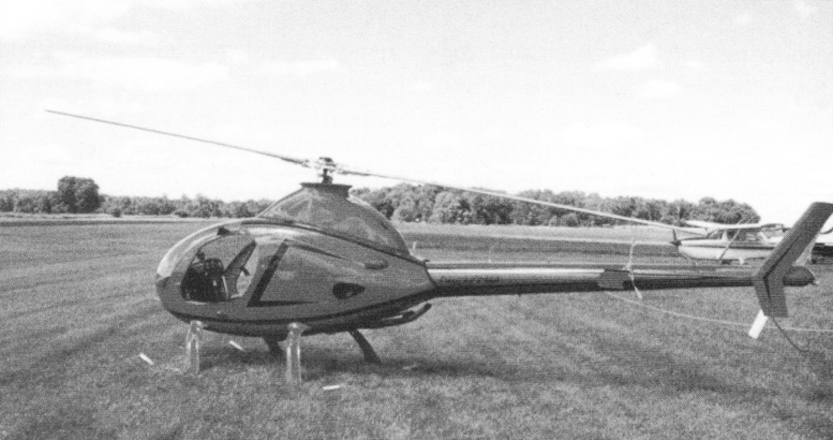
Homer Bell’s Rotorway Exec Helicopter – it was a brilliant cherry red color.
That’s the dream that everyone has. Then I saw this ad about a little homebuilt they made out in Arizona. B. J’s (B. J. Schramm) standing out there beside it with a shotgun in his hand. We sent off for information on that one. And we saw others so we sent off for information on those, too.
In 1971, we moved to a bigger house that had a two-car garage. I said we can build something here. Right about then B.J. had introduced the two-place Scorpion. I said that’s the one we’ve got to have. Now we can carry passengers. This is great. We bought one. When it came, me and a buddy, who had an El Camino, went to the terminal and picked up the box.
It was four feet wide and ten feet long. We took it home and put it on the garage floor. It took me two to two and a half years, piece by piece, as I got money, to put together that first Scorpion II. We actually got it off the ground in 1974 and commenced to try and learn to fly this thing. It took six to eight months to kind of master it. By the spring of 1975, we were flying around the countryside a little bit. Well, we learned an awful lot from that machine, and of course, there were a few problems.
After I sold that machine, I was looking for something else. By now I had learned to be very skeptical with any new models that came along. Do not buy anything until it’s well-proven and well-tested. This is something today that I think the new guys have to realize. There is everything in the world out there that people are pushing to sell. Until it’s been thoroughly tested and proven you’re best to stand by and wait or you’re likely to buy a pocketful of troubles.
Then a friend of mine called and said he had just what I needed. I said what? He said a Scorpion. Just what I needed was another Scorpion! It was older than my first one. My friend bought it for 10 cents on the dollar. I bought it for 25 cents on the dollar. Some of the parts from that helicopter are still flying on my Exec today. In 1980, B.J. introduced the first Exec. And offered a conversion package to all Scorpion owners. I had to have one of those. It was $7,000.
Well, that turned out to be one of the biggest bargains in the homebuilt helicopter market. I had over 200 hours of helicopter time in this Scorpion before I ever had the first hour of helicopter instruction. I taught myself to fly from scratch. And I don’t recommend that. You have to understand that in those days you had the cable hub and our worst enemy was the helicopter pilot. Because it was so different that those guys couldn’t fly it, yet they thought they could.
ROTORCRAFT: You mentioned your wife has soloed.
HOMER BELL: Let me tell you something about Sharon. Her maiden name is Hughes. When B.J. found this out, he wanted to use this as a promotion. He said “You need to teach Sharon how to solo and then bring her to the factory and we’ll solo her and we’ll take a shot of it and we’ll run that in an ad picture.” So I commenced to reach Sharon to fly.
It took us 16 hours, a lot of screaming, a lot of forming, and a lot of saying “We’re not going to get this done. This isn’t going to happen.” It came awfully dose to probably breaking up our marriage! But we got her to the point here I thought she could handle it and we took her out to the factory and Homer Bell’s Exec Stretch and B.J. flew with her awhile and we set up the cameras and she soloed the thing.
ROTORCRAFT: What keeps you busy now?
HOMER BELL: I was a computer repairman for National Cash Register. I worked there for 27 years, and four years ago, they offered a buy out. By then there was a lot of buying and selling of Execs — a big turnover. People were lost. They couldn’t get any help. I’d hear questions like “I got this machine, I don’t know anything about it and it shakes,” or “I can’t get it started,” “I need this, I need that”. I thought maybe there was enough work out there helping these people.
And I was knowledgeable on everything clear back to the Scorpion. Not to brag, I think I am one of the most knowledgeable guys on Rotorways around. I think B.J. will agree with that and so will the factory. There are other knowledgeable people, but I go way back. So I can help those old guys. I thought there was enough market there that I could make a half way decent living. Sharon has insurance coverage for us at her job and the kids are grown. So I can go tinker with helicopters.

Homer Bell’s homebuilt and kit built helicopter fly in 1998.
I test fly machines. And you have to be careful. You see a machine and it looks air worthy, but once you start hovering and flying it — Oh, my gosh the things that can happen! Just to give you one example, we had a machine that was well-built and when we got into it, half the bolts in it weren’t tight. We tightened bolts for two days.
Then we finally got it to where we could do runups. We ran it up to speed. The first time wasn’t too bad. The second time it about shook us off the pad. We got to looking and the builder had put some wooden end-caps in the tail rotor blades instead of aluminum. It looked like it would work, but then we came to find out that he put little tiny wood screws in it that were about an eighth of an inch long, by the time they got through the skin, there wasn’t anything to hold that plug in there. So I’m doing some — I’d have to say, fairly dangerous work. But I’ve been very lucky so far.
ROTORCRAFT: You travel all around doing this, don’t you?
HOMER BELL: I’ ve been to Puerto Rico twice in the past couple of years. This year we’ve been to Florida twice, Puerto Rico, Phoenix, Missouri, Kansas, Nebraska, Chicago, and I even got my couple hundred acres of farming done in-between. So we’ve been staying fairly busy. The year before that we were east coast to west coast. We meet some very interesting people. Most of them are super nice.
ROTORCRAFT: You host quite a fly-in every year. How did that get started?
BELL: In 1980 or so, B.J. offered a dealer program — he didn’t call it that, but he said if you go to a fly-in. promote your machine, help us sell machines, and we’ll give you a little commission and discount on parts. Great, now we can spend some time doing these things and get a little reimbursement. That was fantastic. So I got into it very heavy and tried to make a real business out of it.
I decided to have get-togethers and club meetings. We’d assist people and teach them how to put the kits together. We want these guys to put them together safely so we don’t have these incidents where we have guys using too short screws and bolts that aren’t tight and poor welds and all that. We would have an annual get-together where people would bring their ships in. We could look at them, give them pointers and tell them what they were doing wrong and doing right. And it just grew from there. We had 17 ships the first year. The numbers have varied from that. In fact in 1987 we had 40 machines at Waynesville, Ohio.
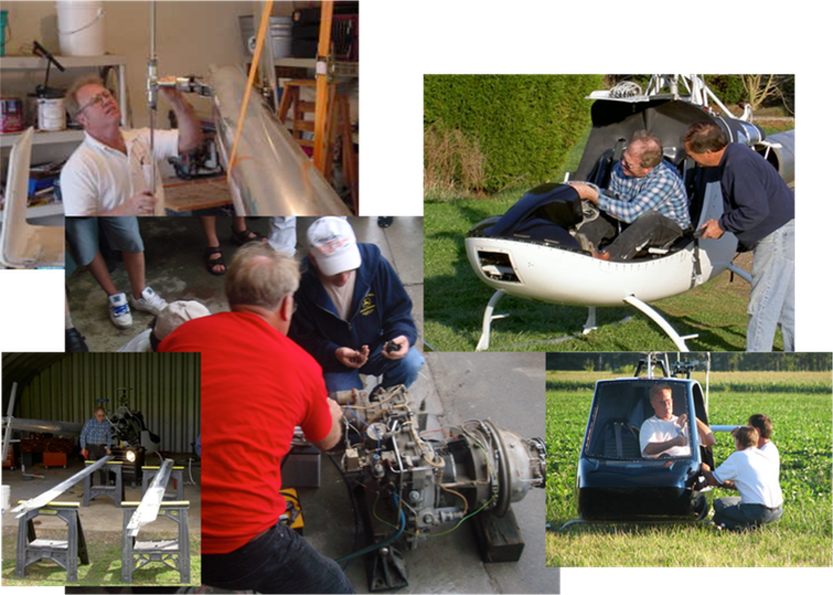
Homer Bell kit helicopter builder assistance.
In 1988, we moved to the new site because by now, we’re starting to get complaints from the neighbors. We were still out in the country and on private property, but people would just stop in the middle of the road and watch. The factory, in the 80’s when B.J. owned it, was always very supportive. When B.J. lost the company in 1990, we lost our support.
The first year after that we didn’t have that fly-in and all the guys said, “You’ve got to have it. We have so much fun down there.” And we did enjoy seeing the people. We have people who come back every year who may not even own a machine any more. It’s become like a family reunion. And I know of no other civilian helicopter event in the country that’s anywhere close to our size. Even at Oshkosh or Mentone not too many come.
ROTORCRAFT: Why do you think that is?
HOMER BELL: I’m not sure, but I think I know what it is. They hate to be restricted. They don’t want a lot of traffic. They like to operate by themselves. They don’t really like to operate at airports.
These guys keep these machines in their backyard. All the rules and regulations just spook them. When they come to our place, we tell them ‘guys, we have wide-open bean fields and cornfields, and here’s a grassy area. Don’t operate close to other ships, and feel free to fly any direction. There’s nothing much around here. Just don’t get lost. There aren’t many landmarks for several miles.’ We kind of turn them loose.
Once in a while we have to get on somebody because we don’t think he’s doing something right. Our worst problem is when a guy brings in a machine that is not an approved kit and he wants to run it up and hasn’t tested it. Well, we tell him ‘You’re welcome to do that, but you take that sucker way down there in the field and after we see you operate for about an hour and if you aren’t having any problems, then you can come up here a little closer. Until then you stay down there. We just tell them like it is. It’s small enough you can do that. I think the PRA get-together 30 years ago was that way. But as you grow, you have to have more restrictions, without a doubt.
ROTORCRAFT: Homer are you as optimistic about sport rotorcraft as you were, say 15 years ago?
HOMER BELL: I’m the eternal pessimist. I’ve been depressed for years because it doesn’t seem like it’s growing that much. It’s growing, but oh, so slowly. Until we get a really inexpensive, reliable bird that everybody can afford, it’s always going to be struggle. And as the population gets bigger, it gets harder and harder to fly out of certain parts of the county without having someone complain about something.
It’s not so bad here in the Midwest, but I hear it from people on the coasts. And it’s depressing. Airports struggle to keep going and stay open. Of course with the helicopter, we don’t have to have airports as much, but the gyros do still. But asI say I’m the eternal pessimist. I just tell it asIsee it. It’s a struggle. We’ve been beating around that 30 ship number at our fly-in for years. And there’s constant turnover. I don’t know what the answer is. We’ve got to get an inexpensive, reliable machine that everybody can afford and is easy to fly.
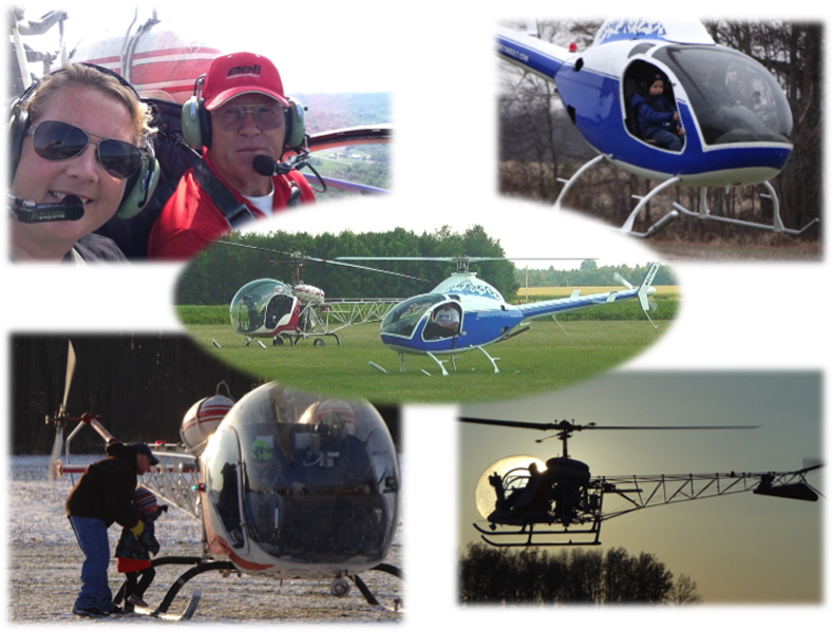
Homer Bell’s kit helicopter flight services.
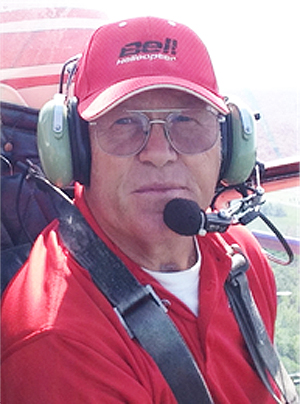

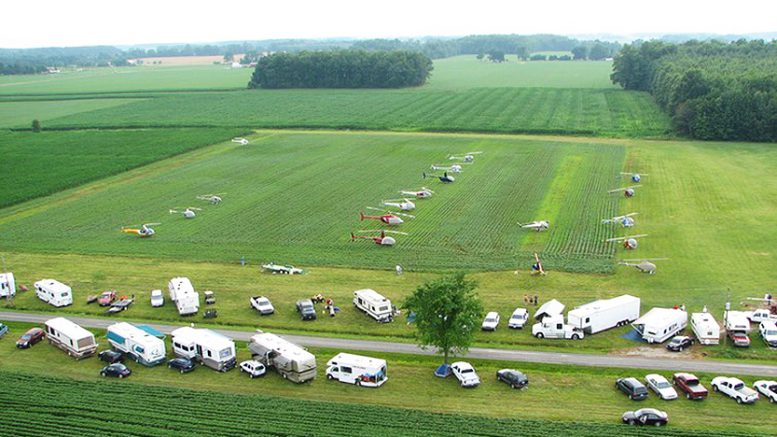
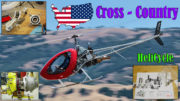
Be the first to comment on "PRA Interview: Homer Bell – Homebuilt Helicopter Genius"